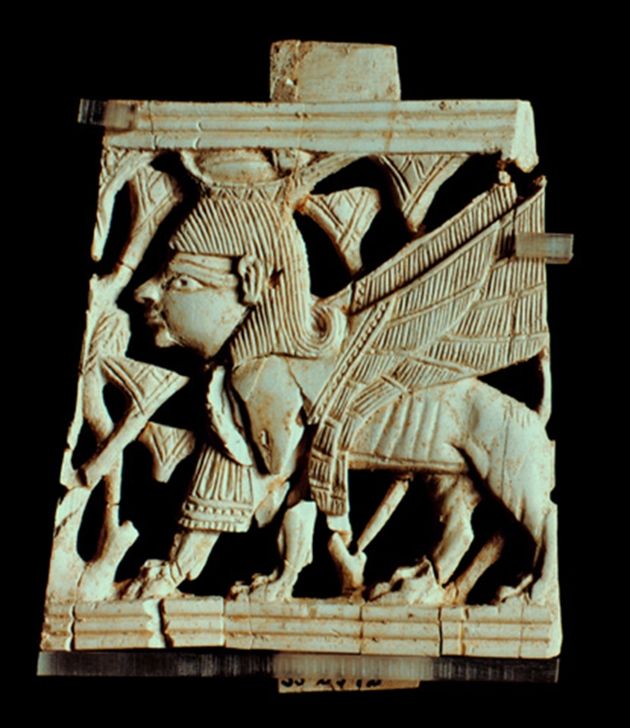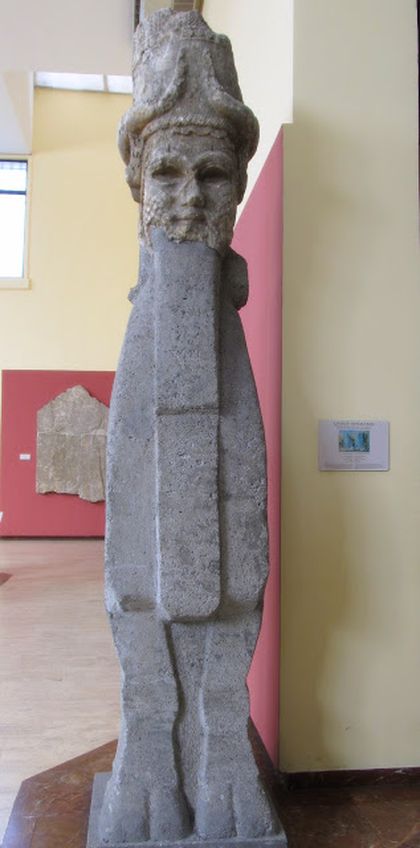Understanding the biblical cherubim in their Near Eastern context
One of the most overlooked items in the Istanbul Archaeological Museum is the 8th century BCE marble Lamassu statue discovered in Assur, Iraq in 1845.
24 APRIL 2019 · 11:55 CET

STATUE OF A LAMASSU
One of the most overlooked items in the Ancient Orient section of the Istanbul Archaeological Museum is the 8th century BCE marble Lamassu statue discovered in Assur, Iraq in 1845 by Austen Henry Layard.
This particular statue was used in the entrance of an Assyrian royal tomb. The Lamassu are roughly the Assyrian equivalent to the cherubim we find in the Bible.
The depiction of Lamassu are not uncommon to find in antiquity. Many were used as elements of Assyrian or Babylonian art and architecture. In Assyria, these creatures were depicted with bodies of either winged bull or lions and heads of human males.
The word Lamassu means “protective spirit” in Assyrian. What makes this piece interesting is that it roughly provides us a visual for the type of thing that Ezekiel might have seen in his visions of the cherubim.
In Ancient Assyria and Babylon, The Lamassu or Shedu were household protective spirits of the common people, becoming associated later as royal protectors, and were placed as sentinels at entrances.
Common placement of these statues was at tombs, city gates, palaces, and royal thrones. They were always placed in pairs flanking the gate or royal throne, facing straight ahead. Sometimes the common folk would engrave these images in clay tablets and bury them in the entrance to their homes as amulets of protection.
In Akkadian culture, the Lamassu and Shadu were associated with the gods Papsukkal and Ishum. Papsukkal was known as the messenger god and gatekeeper to the pantheon. Ishum was a minor god known as a benevolent herald who led the gods in times of war.
One of the reasons that the figure of the Lamassu was used so extensively by royalty was to instill a sense of fear, reverence, and awe in the visitors. These figures were, in essence, a reflection of the grandeur of the kingdom and particularly the king.
These works of art conveyed several metaphorical messages which in turn served as a reflection of the king’s power and splendor.
BIBLICAL SIGNIFICANCE
The name cherubim seem to originate from the Akkadian loan word Karibu, which means “bless”. This word probably explains their role as the ones who Bless god with their praises and chants.
There are several chapters in the Bible that speak of cherubim. In Genesis 3:34 we read that cherubim were placed on the East side of the Garden of Eden after God drove Adam and Eve out. In Exodus 36 we read that figures of cherubim were embroidered into the curtains of the tabernacle.
In Exodus 37 we read that a pair of cherubim faced each other on the cover of the ark of the covenant. The ark of the covenant represented the mercy seat or the throne of God. Likewise in Psalm 99:1 we read that God sits enthroned between the cherubim.
We also see cherubim in several apocalyptic visions. Chief among these is Ezekiel chapters 1, 10, 41, as well as Revelation 4. The descriptions do show slight differences. In Ezekiel's 1 and 10 each cherub has 4 faces and 4 wings. In Ezekiel 42 each has 2 faces.

In Revelation 4, four creatures have each a single face and six wings. However one should keep in mind that these apocalyptic visions and dreams are symbolic in nature and rather than trying to find contradictions in the numbers one should strive to find the meaning in each of their contexts.
The first thing to note in these passages is that most examples of the cherubim in Scripture are to be found in sections of poetry or apocalyptic literature.
This should lead us to believe that the text itself is leading us to interpret the image of the cherubim with symbols and metaphors, not with actual literalism. Cherubim's are spirit beings.
But why depicted in creaturely forms? As is the case with other instances Biblical authors try to make sense of what they see with images that the readers are familiar with.
It should not be surprising then that cherubim are described as such. In order to understand the meaning of these creatures, we have to analyze which ideas these creatures conveyed in their context in antiquity. What did these animals and images represent for their ancient audience?
The figure of the ox was associated with power and strength. Oxen were primarily used in the fields for their muscle power, especially to accomplish tasks such as plowing, threshing, and hauling.
We see similar imagery in Scripture. Proverbs 14:4 states that “abundant crops come by the strength of the ox”.
The figure of the lion was associated with royal majesty. Lions were often used as symbols and emblems of kingdoms. It was the symbol of the Kingdom of Judah. It was used in the seals of the Assyrian kings.
The Assyrians would actually perform lion hunts. Lion-hunting was considered the sport of kings, symbolic of the ruling monarch’s duty to protect and fight for his people. Both Amos and Hosea compare God’s voice to that of a roaring lion: “The lion has roared; who will not fear? The Lord God has spoken; who can but prophesy?” (Amos 4:8); “They shall go after the Lord; he will roar like a lion; when he roars, his children shall come trembling from the west” (Hosea 11:10).
The figure of the eagle conveyed the ideas of transcendence and protection. In ancient Egypt Nekhbet who was portrayed as vulture was the protective goddess of upper Egypt. The eye of Horus, who was associated with the falcon, was seen as a symbol of protection.
The eagle was also used in the seal of the Persian empire. Such creature was known as the Faravahar and also conveyed the idea of protection. Exodus 19:4 states that God bore the people of Israel on eagles' wings and brought them to himself. Psalm 91:4 states, “He will cover you with his pinions, and under his wings, you will find refuge”.
Finally, the figure of the man was associated with the ideas of wisdom and intelligence. Men were distinct from animals. They could rule the world, use language, reason and had self-awareness. In essence, men were the representatives of the gods on earth.
This is the reason that in antiquity many kings were in essence viewed as gods on earth. In Genesis 1:28 we read that man was created in the image of God, different from other creatures, and was given the responsibility to “fill the earth and subdue it, and have dominion over the fish of the sea and over the birds of the heavens and over every living thing that moves on the earth”.
Rather than drawing attention to themselves, the cherubim therefore metaphorically reflect the glory, majesty, power, protection, transcendence, and wisdom of the king. The cherubim inspire fear, reverence, respect, and awe towards the king.
This is the message of these creatures. They bless God and remind us that God is mighty to be praised; that he is Holy and must be guarded against defilement; that He is King of kings to whom which no earthly king can compare. Only He is the true ruler of the Universe.
BIBLIOGRAPHY
- Dr. Rabbi Zev Farber. “The Cherubim: Their Role on the Ark in the Holy of Holies.” https://thetorah.com/the-cherubim/
- Gornold-Smith, Christopher (2014). “What Are Cherubim?” [Video]. Retrieved from https://www.sagu.edu/sagutv/what-are-cherubim
- Mckee, Gabriel. “Austen Henry Layard and the Early Exploration of Nimrud.” Institute FOr Study of the Ancient World. New York University. 05/07/2015. http://isaw.nyu.edu/library/blog/Layard
Published in: Evangelical Focus - Archaeological Perspectives - Understanding the biblical cherubim in their Near Eastern context
